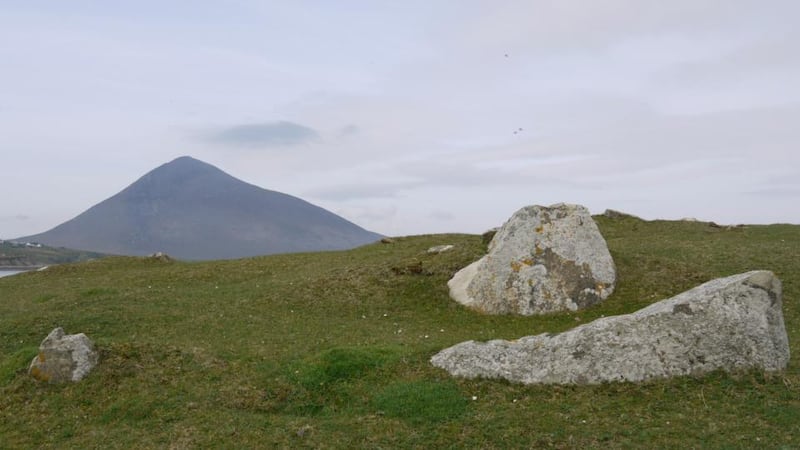Something better than death
I did not find
During my visit to this earth

My eternal sleep
Already it started
Within you, mother
I left you even before I lived
I am nowhere forever
The sound of the sea
Barred from paradise
Barred from hell
Where to instead?
These lines are by the photographer, artist and writer René Böll, whose imminent poetry collection is called Under the Mackerel Sky and subtitled Cillíní – The Dead Children of Achill. The cillíní, unbaptised children's graveyards, are also the subject of Böll's exhibition at Cork City Hall.
Böll, son of the late German writer Heinrich Böll (winner of the Nobel Prize for Literature in 1972), has photographed 25 cillíní on Achill Island and has created abstract oil paintings inspired by the grave sites. The photographs, taken during the summer a couple of years ago, depict unremarkable-looking, low-sized stone monuments, sometimes with the sea in the background.
But they tell a heartbreaking story that is a stark reminder of our dark history, when babies who died before baptism were buried in unconsecrated ground, alongside illegitimate children and their mothers, the mentally ill, people who took their own lives, murderers and those who were washed up ashore, their religion unknown.
This happened throughout Ireland up to the 1960s, and, according to some historians, even until the 1970s. (Unbaptised babies, according to St Augustine, were condemned to hell. The concept of limbo – an in-between place where the infants would not suffer but would never go to heaven – was later introduced by the Catholic Church, and subsequently abolished.)
Many children who had died before baptism were buried at night by their fathers or male relatives. Mothers were not allowed to be present at the clandestine burials, some of which took place in fairy forts. According to superstition, these were safe places. The graves were marked with small, uninscribed stones. Over time, many cillíní sank into the surrounding landscape and are now impossible to find. Others have been restored.
Summers on Achill
Böll, who lives in Cologne, has fond memories of childhood summers spent holidaying on Achill island with his family. His father, who wrote a travelogue about island life, owned a cottage on Achill that is now a residence for artists and writers. Böll became aware of the cilliní when he was about eight or nine years old.
“Somebody told my father about the cilliní, and he showed us one on a cliff,” he says. “We were really shocked. It’s very sad because there are no names on the graves, no flowers, nothing. We knew there were more, but nobody showed us them.”
Böll says he is “astonished” that many Irish people are unaware of the cillíní, “even in the countryside. That must be because nobody spoke about them. Because the cillíní are not marked, you would pass over them. You have to know exactly what you’re looking for to find them.”
He started to work on the project about eight years ago. “I went to Achill Island and spoke with people and looked for historical sources. I found 25 cillíní on the island and on the Currane peninsula. There are more. I didn’t find anyone who had buried a child. Most families with a cillíní connection have died. I want to continue my work on the cillíní, writing about it and making more paintings.
“I hope to find somebody who wants to speak about it. It’s very difficult for families, so I respect anyone who doesn’t want to speak about it.”
While the cillíní are usually found in remote places, Böll says some are near houses “and there is one on Achill Island that is 50m from the hotel. I took hundreds of photographs of the cillíní. They’re just normal stones, some like quartz. The paintings I made inspired by the cillíní represent something you can’t see but which is there. I know the story behind the cillíní but I can’t see anything that tells me the story.”
Others besides Böll are now trying to ensure that the people buried in the cillíní are not forgotten. Some of the cillíní on Achill Island were blessed about 12 years ago. An organisation called Hidden in Unconsecrated Ground was established in 2011. The group is led by archaeologist Toni Maguire, who is based at Belfast's Milltown Cemetery and has been overseeing excavations to find interments as well as offering comfort to relatives. Böll refers to "a very good documentary", Island of the Dead, directed by Donal R Haughey, which was screened on TG4 in 2012. The film recreates the journey of a baby buried in a cillín in Donegal.
Böll, who is a father of two and grandfather of two, divides his time between his own work and looking after his father’s literary estate. He finds Achill very inspiring. “It’s an incredible place. I go there every year for a week or so. For me, it’s like coming home. I like being near the sea. The light is always changing.”
Thanks to the work of Böll and others, the perception of these unjustly treated people who were born in less enlightened times is also changing at last.
- The Cillíní of Achill Island and Currane is at Cork City Hall until April 24th, celebrating the city's sister partnership with Cologne. The exhibition tours to Achill Sound Hall as part of the Heinrich Böll Memorial Weekend, May 1st-3rd










